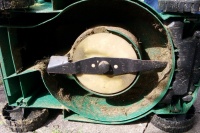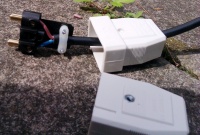Lawn mower
Machine types
Cylinder mower
These cut neatest, producing a striped lawn. They use less energy than rotaries for a given job. But they don't tolerate rough ground, can't cut long weeds, and the blade arrangement does need maintenance now & then.
Rotary mower
More capable all round, light mowers can be lowered onto large weeds, and at a push can even gradually level lumpy ground. The blade can work without maintenance if it must. Stone tolerant to some extent. But results aren't as neat & tidy.
Hover
Easier to move around obstacles. Prone to grounding on peaks.
Scythe
Effective for clearing overgrown areas - a long handled scythe can clear faster than power tools. Correct technique takes a little practice. Obvious injury potential.
Allen scythe
aka Power scythe. A petrol powered hedge trimmer on wheels, good for clearing overgrown land.
Strimmer
Good for edging, much too slow for lawn mowing
Propulsion
Small tractor
Used with gang mowers for the largest areas.
Ride-on
The only good option for large lawns. Top speed varies fairly widely, and can make a big difference.
Self propelled
Good choice for the average lawn
Not self propelled
Wheel size, weight & handle angle determine how much work they are to push. Rollers sink into dips much less than wheels. Fine for small to medium lawns if your health is ok.
Push mower
Some folk like the exercise of a non-powered mower. If you've not tried one the average lawn is fairly demanding, and cutting it in one go is well beyond someone that doesn't get regular exercise.
Cordless
Robot
Blade types
Rotary mowers come with 2 main blade types:
Metal blade:
- Keeps on cutting, given an occasional sharpen
- Can cut through thick weeds in limited numbers, level molehills etc
- Serious foot injury potential
Plastic blades:
- Need regular replacement
- Muck on the blade holder stubs can cause them to come off frequently
- Less effective than metal blades, generally
- Don't cut tough weeds
- Relatively toe safe
- If they keep coming off, try shorter blades
Electrical connectors
- Always use a connector with the same number of pins as the flex has cores
- NEVER fit a connector with pins on the mains plug side, or you'll have live pins sticking out. Its always socket with holes nearest the mains plug, plug with pins nearest the motor
- If the connector has a cover you have to thread the flex through, don't forget to put the cover on first!
- Some have assymetric cord grips that can be turned the other way up to take thicker or thinner flex
- There are a few different patterns of mower connectors available - needless to say none is compatible with other types.
Electric vs petrol
Electric:
- Lower power generally
- Lead gets in way
- Risk of chopping lead
- Limited range
- Cheaper
- Near zero maintenance
Petrol:
When it won't start
Fault diagnosis is a wide & complex topic, but the following homes in on the majority of faults.
In most cases the problem is either with fuel or spark. Test for presence of spark with a neon in series with the spark plug lead - keeping yourself well away from the very high voltage. Test for fuel problems by spraying easystart or similar into the air intake and trying to start it.
Historic mowers
There are still some 1950s mowers giving good service. Atco is one of the longest lasting brands. The one thing to beware of is uninsulated sparkplug connections - touching one is not a mistake you'll make a 2nd time!
Safety
The main issues are
- Foot injury from metal blades can be severe
- Electrical connectors on wet grass - don't mow when wet
- Blade cutting electrical lead
- CO output from exhaust in a shed/barn. CO can be lethal
- Exposed high voltage on spark plugs with historic mowers
Repair Links
Reviews
MTD Lawnflite 703 ride-on. Also see [1]
Disposal
There are always people wanting working petrol engines

